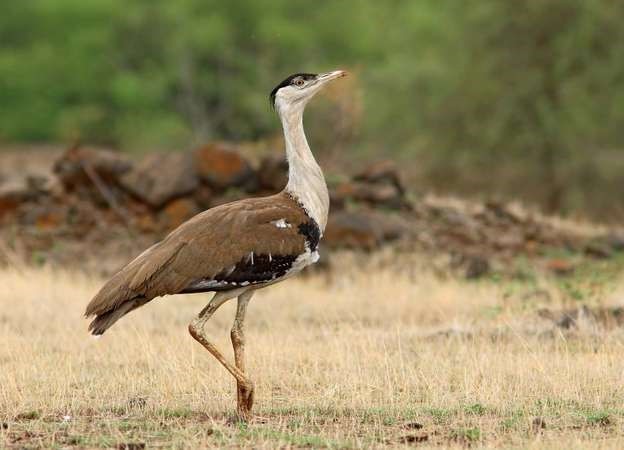Context: The Supreme Court intervened on behalf of the critically endangered Great Indian Bustard ‘s over the birds falling dead after colliding with power lines running through their dwindling natural habitats in Gujarat and Rajasthan.
- A Bench led by Chief Justice of India will examine on a priority basis whether overhead power cables can be replaced with underground ones to save one of the heaviest flying birds on the planet.
- Bustards generally favour flat open landscapes with minimal visual obstruction and disturbance, therefore adapt well in grasslands.
Great Indian Bustard
- It is listed in Schedule I of the Indian Wildlife (Protection) Act, 1972.
- It is covered by the Convention on Migratory Species.
- It is covered in Appendix I of the Convention on International Trade in Endangered Species of Wild Fauna and Flora (CITES).
- It is listed as Critically Endangered on the IUCN Red List.
- It has also been identified as one of the species for the recovery programme under the Integrated Development of Wildlife Habitats of the Ministry of Environment and Forests, Government of India and the National Wildlife Action Plan (2002-2016).
- Today, its population is confined mostly to Rajasthan and Gujarat.
- Small population occur in Maharashtra, Karnataka and Andhra Pradesh.

- The Great Indian Bustard, one of the heaviest flying birds, can weigh up to 15 kg and grow up to one metre in height.
- Less than 200 birds are left now, of which about 100 are in Rajasthan and if it is not protected, it would become the first mega species to disappear from India after Cheetah in recent times.
- Alarmed by this, the Union Ministry of Environment and Forests (MoEF) prepared a species recovery programme for the Great Indian Bustard, the Lesser Florican and the Bengal Florican, three of the four bustard species found in India.
- All the three birds have been endemic to the grasslands of India and are on the brink of extinction. The fourth one, Houbara, is a migratory species.
- They breed mostly during the monsoon season when females lay a single egg on open ground.
- Males have a gular pouch around their neck, which helps produce a resonant booming mating call to attract females and can be heard up to a distance of 500 metres.
- Males play no role in the incubation and care of the young, which remain with the mother till the next breeding season.
- Rajasthan forest department, finally announced its own Project Great Indian Bustard. The bird also happens to be the state bird of Rajasthan.
- The Plan involves constituting enclosures and securing inviolate areas to ensure successful breeding of birds in the Desert National Park.
- A good number of birds are also found outside protected areas in Ajmer and Jaisalmer districts.
- Habitat loss and degradation appear to be the primary causes of decline.
Integrated Development of Wildlife Habitats (IDWH)
- The National Board for Wildlife (NBWL) recently added four species- the Northern River Terrapin (Critically Endangered), Clouded Leopard (Vulnerable), Arabian Sea Humpback Whale (Endangered), Red Panda (Endangered) – to a Recovery Programme for Critically Endangered Species.
- It should be noted that all the animals listed under this programme are actually not critically endangered as per IUCN Red List.
- The progamme is one of the three components of the centrally funded scheme, Integrated Development of Wildlife Habitats (IDWH).
- Started in 2008-09, IDWH is meant for:
- providing support to protected areas (national parks, wildlife sanctuaries, conservation reserves and community reserves except tiger reserves),
- protection of wildlife outside protected areas and
- recovery programmes for saving critically endangered species and habitats.
- So far, 17 (now 21) species have been identified under the recovery programme.
- These are the Snow Leopard (Vulnerable), Bustard (including Floricans – both Critically Endangered), Dolphin (Endangered), Hangul (Critically Endangered), Nilgiri Tahr (Endangered), Marine Turtles, Dugongs (Vulnerable), Edible Nest Swiftlet (Least Concern), Asian Wild Buffalo (Endangered), Nicobar Megapode (Vulnerable), Manipur Brow-antlered Deer (Endangered), Vultures, Malabar Civet (Critically Endangered), Indian Rhinoceros (Vulnerable), Asiatic Lion (Endangered), Swamp Deer (Barasingha – Vulnerable), and Jerdon’s Courser (Critically Endangered).
- Both Irrawaddy Dolphin and Ganges River Dolphin are Endangered.
- Protected Areas, viz., National Parks, Sanctuaries, Conservation Reserves and Community Reserves covering important wildlife habitats have been created all over the country under the provisions of the Wild Life (Protection) Act, 1972 to conserve wild animals and their habitats.